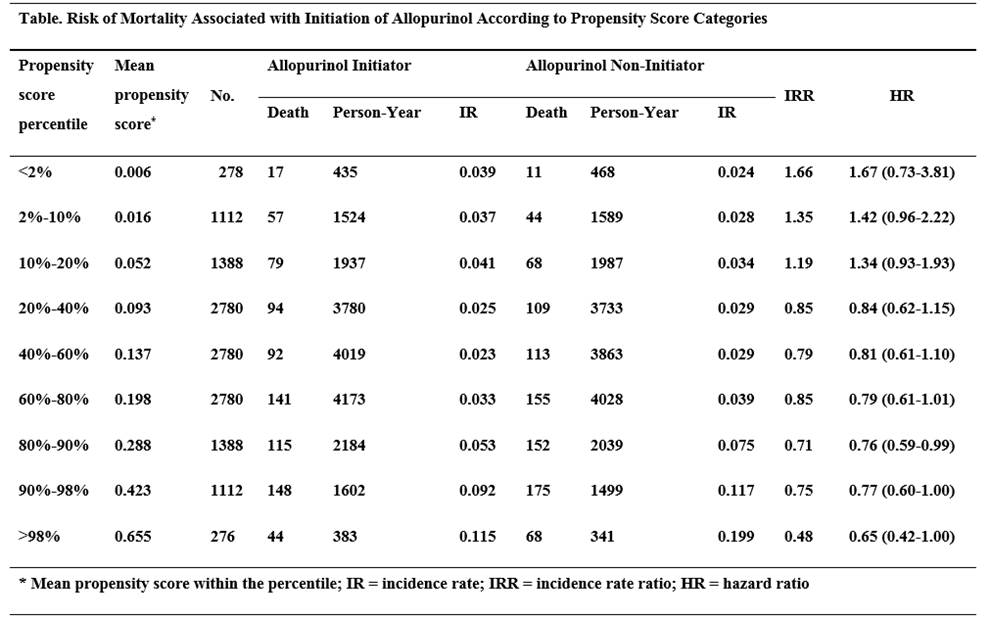Session Information
Session Type: Abstract Submissions (ACR)
Background/Purpose: Several studies have reported that allopurinol use is associated with a decreased risk of death or cardiovascular outcomes. While these studies reported the overall average effect of allopurinol, the impact may vary depending on the patients’ characteristics. This line of research could help identify patients who will get the greatest benefit from allopurinol use, as well as those who may face a hazardous impact (thus conferring a patient-oriented, personalized medicine approach). To address these issues, we assessed whether the survival impact of allopurinol varies across the distribution of propensity scores (PS) in a general population-based cohort study.
Methods: We conducted an incident user cohort study with PS matching using a UK general population database. Eligible subjects were aged ≥40 years and had a record of hyperuricemia (serum urate >357 μmol/L for women and >416 μmol/L for men) between January 2000 and May 2010. For each 6-month period during the study follow-up, each allopurinol initiator was matched to a non-initiator by PS using the greedy-matching method. Subjects were followed until death, loss to follow-up, or the study period ended, whichever came first. We calculated the all-cause mortality rate and examined the association of allopurinol initiation with the risk of mortality using a Cox proportional hazard model. We then examined whether the effect of allopurinol varied across PS level categories (Table).
Results: Our study included 6,947 allopurinol initiators and 6,947 non-initiators. All measured potential confounders were evenly distributed between the two groups. The mortality rate was 39/1000 person-years in allopurinol initiators and 46/1000 person-years in non- initiators, resulting in an overall HR of 0.86 (95% CI: 0.78-0.96). Our subgroup analysis by PS showed a reversal of HR from hazardous in the lowest PS groups (HR of the lowest PS group, 1.67) to increasingly protective with higher PS groups (HR of the highest PS group, 0.65) (Table). The most obvious difference in patient characteristics between the top and bottom 20th percentile PS groups was the presence of gout (>98% vs. 38%), suggesting that treatment of gout patients is life-saving (compared to the hazardous impact of treating asymptomatic hyperuricemia).
Conclusion: Our findings suggest that the association of allopurinol with the risk of all-cause mortality may vary widely from conferring a protective versus hazardous impact, according to patients’ characteristics (reflected in PS). However, a potential alternative explanation may be extreme levels of residual confounding. Nevertheless, if confirmed, these potentially opposite subgroup effects would help to identify individuals who will receive the maximum benefit from allopurinol, thus helping to achieve a germane patient-oriented, personalized medicine approach in this common practice context.
Disclosure:
N. Lu,
None;
H. K. Choi,
Takeda,
5,
AstraZeneca,
5;
M. Dubreuil,
None;
Q. Louie-Gao,
None;
Y. Zhang,
None.
« Back to 2014 ACR/ARHP Annual Meeting
ACR Meeting Abstracts - https://acrabstracts.org/abstract/can-allopurinol-survival-impact-reverse-depending-on-patients-characteristics-a-propensity-score-based-subgroup-analysis/

